|
|
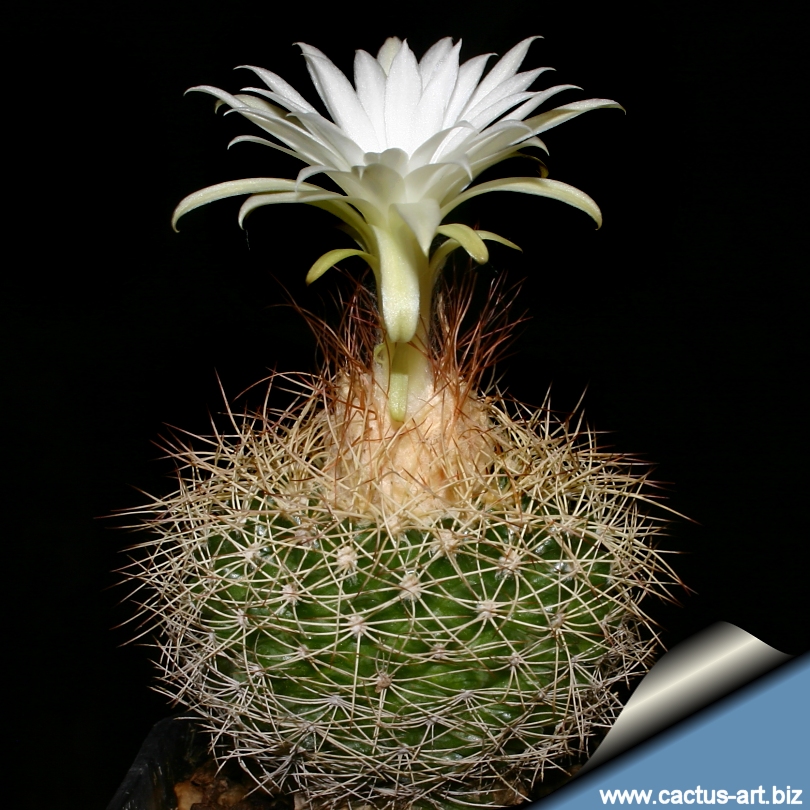
Discocactus zehntneri v. horstiorum
UH667
(Discovered by leopoldo Horst near Minas do
Mimosa, Moreno, Bahia, Brazil 1000m in 1988)
It has flexible, interlacing spider-like spines that cover the plant.
|
|
Description:
D. zehntneri v. horstiorum is a squat tiny little solitary
plant that - in culture - produces just like D. boomianus many
offsets. This plant is very similar (if not the same) to D.
zehntneri subsp. zehntneri.
Stem: Dull-green 10-20 in diameter and 7-10 cm tall.
Cephalium: Up to 1 cm tall and -4 cm wide, at the apex of the
plant, creamy-withe to light-brown with yellow to brownish bristles up
to 2 cm..
Ribs: About 20, somewhat spiraled, forming nipple-like tubercles
to 1 cm high.
Areoles: Oval, sunken, ca. 8 per ribs.
Radial spines: Interlacing, densely covering the plant, 10 to15
up to 1-2 cm long, pectinate, flexible spines creamy white or
whitish-yellow with dark tips, becoming pale-brown to whitish, recurved
backwards, sitting on the plant like spiders.
Central spines: None.
Flowers: White, scented, slender funnelform, up to 9 cm long. The
position of the stigma is at the top of the stamens. Each flowering
lasts only one night, but that night it produces many flowers.
Fruit: Club-shaped red 2,5 cm long. The plant produces seed-pods
twice a year, when it flowers.
|
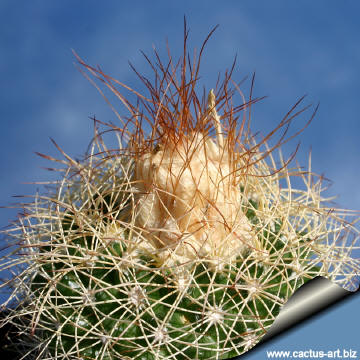
11.00 A.M.
No sign of flowering at all... |
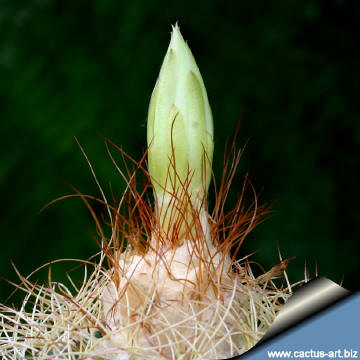
6.00 P.M.
... a bud is growing up ... |
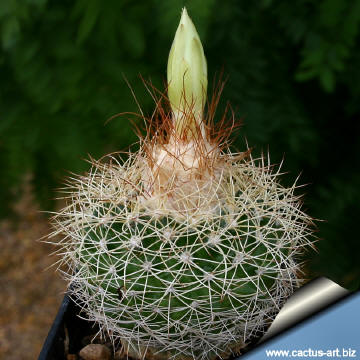
7.00 P.M.
... it is almost ready to open ... |
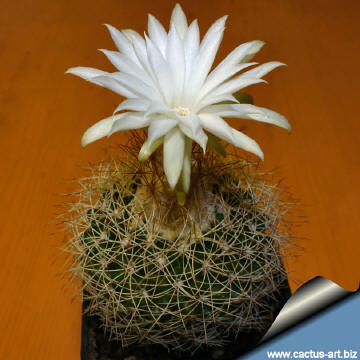
8.00 P.M.
... the flower at full anthesis!!! |
|
Cultivation: Discocactus
zehntneri v. horstiorum is one of the easiest species of the genus
to grow, but even so it isn't a plants for beginners, in fact collectors
consider the Discocactus to be rarities with requires skilful
cultivation. It is rather difficult to grow and frost tender, it can’t
stand cold, or even fairly cool temperatures and should be kept at above
15° C if grown on its own roots (8°C if grafted). Need full sun or
afternoon shade. They are slow growing and very rot prone when kept on
their own roots and though they can’t endure long stretches of total
dryness, too much water will rot them, as their weak root systems tend
to be inefficient at sucking up water from wet soil. They generally
resent being repotted and can take a long time to establish. When grown
to maturity, however, it possess an exotic look shared by no other
cacti, and it generally attract a lot of attention.
Propagation: Seed or
cuttings. Young seedlings are generally grafted on a low stock to keep
the plant in a good shape.
|
|
Photo of conspecific taxa, varieties, forms and cultivars of
Discocactus zehntneri.

 |
|
Advertising
|
|
|
|
Family:
Cactaceae (Cactus
Family)
Discocactus zehentneri ssp.
horstiorum
Accepted
Scientific name: Discocactus
zehntneri Britton & Rose 1922Subfamily: Cactoideae
tribe: Trichocereeae.
Origin: Southern Brazil (altitude around 1000-1200 mt )
Conservation status: Listed in
CITES appendix 1.These species are
threatened with extinction.
Synonyms (of Discocactus zehentneri):
- Discocactus zehntneri ssp. albispinus
(Buining et Brederoo) P.J.Braun & Esteves 1995.
- Discocactus zehntneri boomianus (Buining
& Brederoo) N. P. Taylor & Zappi 1991
- Discocactus zehntneri subsp. araneispinus
(Buining et Brederoo) P.J.Braun & Esteves 1995.
- Discocactus zehntneri ssp. horstiorum
- Discocactus zehntneri var. horstiorum
- Discocactus zehntneri ssp.buenekeri
|
|
|
|
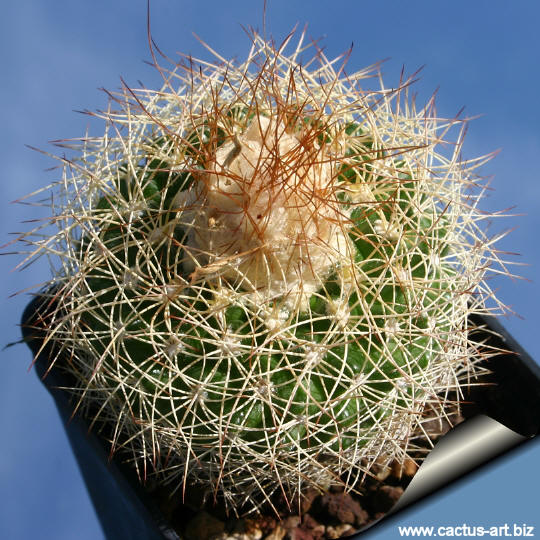
The cephalium at the apex of the plant is creamy-white
with yellow to brownish bristles up to 2 cm..

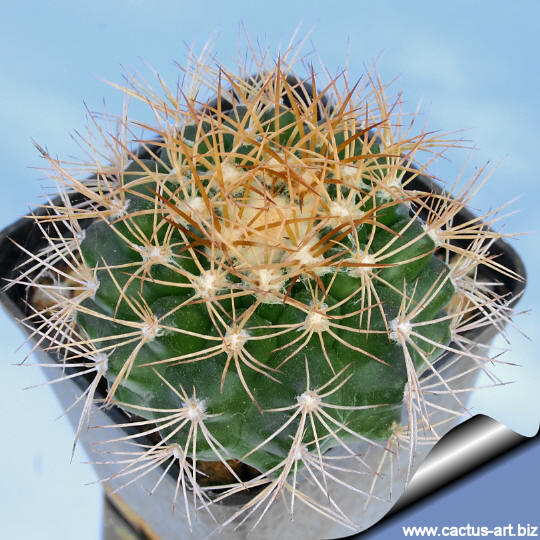
This plant is part of the D. zehentneri
complex which comprises several variable subordinates taxa, but not
all are universally recognized. Some
authorities recognize the following :
subsp. zehntneri Usually globose and
completely covered in white thin, needle-like spines, the flower is
about 3 cm long and the fruit are red (Origin: Sentocé)
subsp. horstiorum = subp zehntneri (Origin: near
Minas do Mimosa, Moreno, Sierra do Espinahaco,
Bahia )
subsp. boomianus Usually disk -shaped, with dark tipped
yellowish spines, the flowers are up to 9 cm long (Origin: Sierra do
Espinahaco)
subsp. buenekeri this species does share the complex
commonality of tuberculate ribs and basal offsetting, but its white,
club-shaped fruit does not fit with the dark red , much elongated and
slender fruit of the other taxa.
subsp. araneispina has flexible,
interlacing spider-like spines that cover the plant.
subsp. albispina
|
|